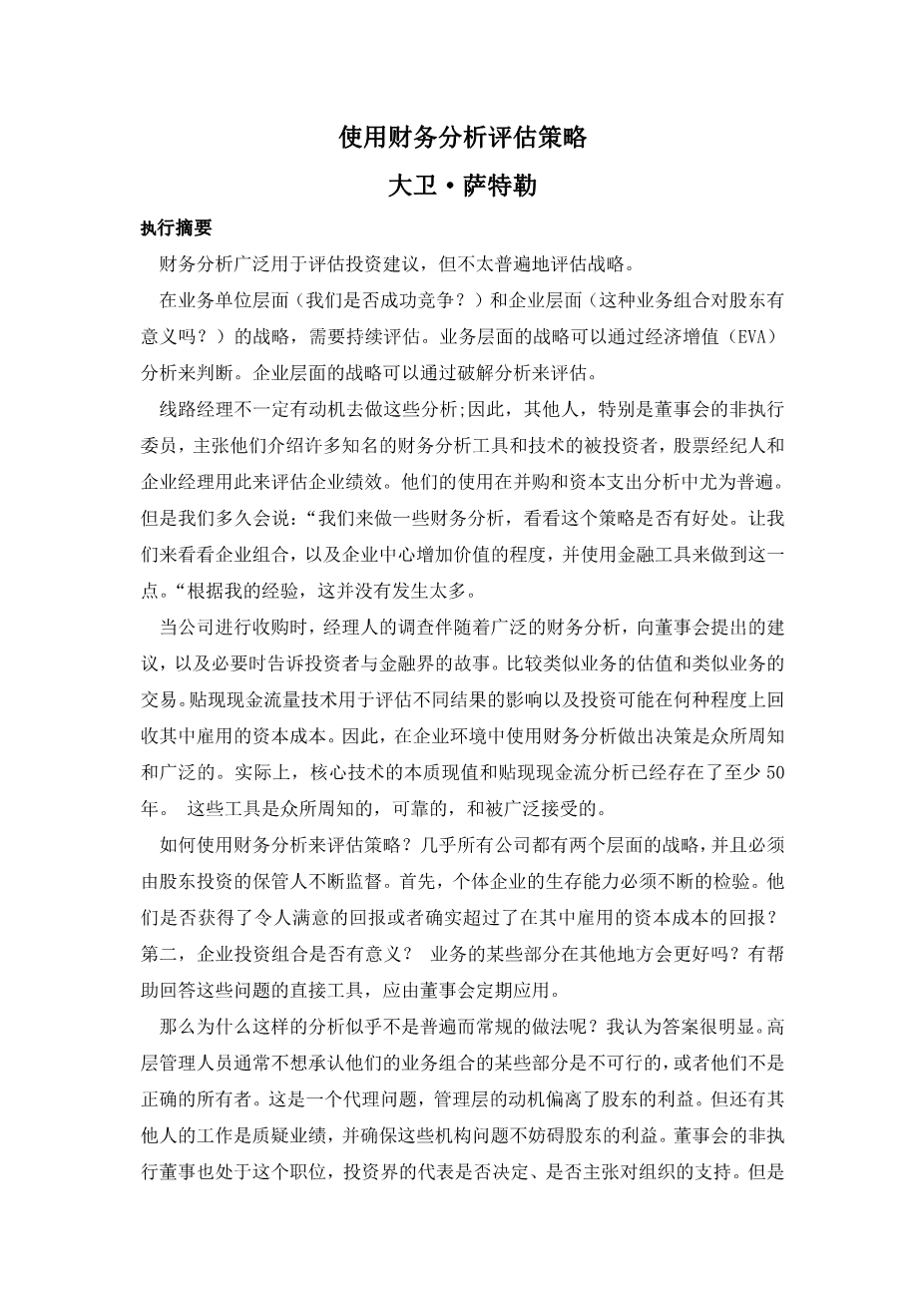Using Financial Analysis to Evaluate Strategy
By David Sadtler
Executive Summary
Financial analysis is widely used to assess investment proposals, but less commonly to evaluate strategy.
Strategy, both at business unit level (are we competing successfully?) and at the corporate level (does this portfolio of businesses make sense for the shareholders?), needs continuing evaluation.
Business-level strategy can be judged by economic value added (EVA) analysis.
Corporate-level strategy can be assessed by breakup analysis.
Line managers are not necessarily motivated to do these analyses; it is thus up to others, especially the nonexecutive members of the board, to advocate them
Introduction
Many well-known tools and techniques of financial analysis are used by investors, stockbrokers, and corporate managers to assess corporate performance. Their use is particularly prevalent in mergers and acquisitions and in the analysis of capital expenditure. But how often do we say: “Let’s do some financial analysis to see if this strategy is any good. Let’s take a view on the corporate portfolio and the extent to which value is added by the corporate center and use financial tools to do it.” In my experience, this doesn’t happen much.
When companies undertake an acquisition, extensive financial analysis accompanies the investigation by managers, the proposals put to the board, and, if necessary, the story that is told to investors and the financial community. Comparisons are made with valuations of similar businesses and with transactions of a similar nature. Discounted cash flow techniques are used to assess the impact of different outcomes and the extent to which the investment is likely to recover the cost of capital employed in it. So the use of financial analysis for decision-making in the corporate environment is well known and widespread. Indeed, the essence of the core technique—present value and discounted cash flow analysis—has been around for at least 50 years. The tools are well known, credible, and widely accepted.
What about using financial analysis to assess strategy? In nearly all companies there are two levels of strategy that must be kept under constant surveillance by the custodians of stockholder investment. First, the viability of the individual businesses must be constantly examined. Are they earning satisfactory returns—or, indeed, returns in excess of the cost of capital employed in them? Second, does the corporate portfolio make sense? Would some parts of the business be better off elsewhere? There are straightforward tools to help in answering these questions and they should be regularly applied by the board of directors.
Why then does such an analysis not seem to be a widespread and regular practice? I think that the answer is pretty obvious. Top managers often do not want to admit that some parts of their business portfolio are unviable or that they are not the right owners. It’s an agency problem, where management’s motives diverge from the interests of the stockholders. But there are others whose job it is to question performance and to be sure that these agency problems do not stand in the way of the interests of stockholders. Nonexecutive directors on the board of directors are in this position, as are representatives of the investment community who decide on whether to advocate support for the organization. But to assess strategy—both at the corporate level and at the level of the individual business—they need suitable tools.
Corporate-Level Strategy
Corporate-level strategy, as comprehensively described in the writings and teachings of the Ashridge Strategic Management Centre (see the More Info section) involves ensuring that value is added by the corporate center to each and every business unit within the portfolio. A number of useful frameworks and techniques have been available for some time to test the quality and intensity of corporate value added. Managers at both the business unit level and at the corporate center can be challenged to explain the exact nature of corporate value added (what do you do to make this business more successful and thus more valuable?). Long-term competitive performance (market share in key segments) can be used to assess the center’s role in ensuring lasting commercial and financial viability. Comparison of the management structure and style with key comparator companies (especially those with more successful financial performance) can be used to assess both strengths and weaknesses in value added.
It is thus possible to take a reading on whether or not the corporate owners are doing an adequate job. The owners must address two questions: first, do we really add substantive value to each of our businesses; and, second, what businesses should we be in?
But these tests are qualitative. They make use of individual judgments, recollections, and viewpoints. While often pertinent and relevant, they can also be dreadfully biased. An alternative is to make the evaluation a quantitative one.
A straightforward financial tool is available to assess the overall success of the parenting capability of any big company, namely, breakup analysis. Breakup analysis takes an arm’s length view of the market value of each of the company’s businesses and compares the total of these values with corporate market capitalization, which is the value the marketplace places on the corporation as a whole. If the latter is less than the former, corporate strategy isn’t working. The market is saying that the corporate center is destroying value. Synergies are not believed.
The operating profit includes deductions from revenues for the cost of goods sold and for the operating expenses. Interest expense is then subtracted to cover the cost of the debt capital used, income taxes are then subtracted, and, finally, a cost for th
剩余内容已隐藏,支付完成后下载完整资料


英语译文共 3 页,剩余内容已隐藏,支付完成后下载完整资料
资料编号:[485803],资料为PDF文档或Word文档,PDF文档可免费转换为Word


